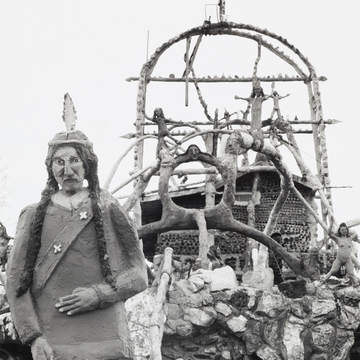Thunder Mountain, in the tiny village of Imlay, was built by Frank Van Zant, an Oklahoma-born Native American, environmental folk artist, and spiritual healer who moved to Nevada in 1968 because he believed that a mountain of the same name, part of the Humboldt Range, held spiritual powers. He took the name Chief Rolling Mountain Thunder and named his creation after the nearby peak. The three-story main structure is made of found objects, including bottles, rocks, auto parts, animal bones, wood scraps, railroad ties, and tiles, all held together by concrete. Inside are nine rooms and a staircase—made of bicycle wheels and handlebars—that provides interior structural support. The irregularly placed windows are glazed with windshields and television picture tubes. Human faces and figures incorporated into the construction seem to gaze at the visitor. Metal pipes rise to form a curving framework like a giant basket handle, so that,
Van Zant said that he built Thunder Mountain to commemorate the Native Americans who came before him and to celebrate their closeness to the earth. By using discarded objects, he commented on the wastefulness of modern Euro-American society. The five-and-one-half-acre site is owned by Van Zant's family and is open to the public.

